by meghanleborious | Feb 27, 2022 | Notes on Practice
Today I went to the woods to dance for the third day in a row. The only footprints in the surface of the snow were my own from the previous day. I choose a spot close to the river and walked a big circle to dance inside of to set a container for myself.
It took some exertion to get started given the crusted over surface of the snow, but once I moved around more, taking care to visit every part of the circle, the going got easier.
The low afternoon sun cut through the bare trees and dazzled my vision. It was hard to avoid meeting the sun’s eyes, and brightly colored yellow, then red afterimages flashed on the snow, always disappearing as soon as I turned to them.
In Flowing, my focus tends to be soft. My eyes are slightly lowered, gaze often resting not far from my circling feet. When I’m dancing with others, I sense and internally acknowledge the people around me, but don’t typically make direct eye contact.
In the woods today, it took awhile to let some of to-do list types of thoughts run though. As I brought my attention again and again to my feet, my breath started to deepen, and my senses became more noticeable.
The first sign that Staccato started to break through was that my gaze lit on a tree across the clearing, and I directed my attention to it. In Staccato, my eyes lift to my personal horizon line. They seek and find. I turned sharply to a different tree, then to a spot in the river. Then to yet another tree 180 degrees behind me, aligning my gaze with sharp, clear gestures.
Dancing with others, this is often the moment that I’m called to partnership. When I’m drawn into someone else’s field and I don’t question it, I just move toward and step in. I might meet someone’s eyes and smile. I might do a full turn while tipping my head back to hold their gaze the entire time. I might have a conversation in gestures, or any other kind of exchange.
 Today I was strongly aware of the transition from Staccato into Chaos, because of how my relationship to gaze shifted. In Staccato, my eyes would find something, then I would lock into it, narrow my field, and respond. But when my gaze started to land on things at the same time that I was starting to respond to them, I started to feel the shift into Chaos. Whereas in Staccato, my vision was targeted, in Chaos, vision started to attend more to the peripheries, scanning rapidly for movement at the edges of my field of vision. As my head and body released more and more, vision started to get blurry, and flashed through sky, trees, river, feet, and snow with increasing speed.
Today I was strongly aware of the transition from Staccato into Chaos, because of how my relationship to gaze shifted. In Staccato, my eyes would find something, then I would lock into it, narrow my field, and respond. But when my gaze started to land on things at the same time that I was starting to respond to them, I started to feel the shift into Chaos. Whereas in Staccato, my vision was targeted, in Chaos, vision started to attend more to the peripheries, scanning rapidly for movement at the edges of my field of vision. As my head and body released more and more, vision started to get blurry, and flashed through sky, trees, river, feet, and snow with increasing speed.
In Lyrical something interesting often happens when I’m dancing outside. I start to notice sound in a different way. It’s like all the racket I was making in Chaos ceases and hearing is turned up. Sometimes my gestures are similar to how I was moving in Chaos, but it sounds really different. My gaze lifts up and sees more space. I start to see patterns everywhere – the ripples on the water, the overlapping branches and roots, the drifted snow.
When I’m dancing with others, I might meet different people’s gazes and move quickly throughout the room, taking everyone as a partner, seemingly at once. I might also dance with something I’m sensing just above the people, or race through with a partner, playing hide-and-seek or lead-and-follow, as connected when we’re side by side as we are across the room, somehow seeing each other even when our line of vision is blocked by other dancers.
In Stillness, the gaze might become internal and (for lack of a better word) cosmic. This is when mundane vision might recede. Sometimes it’s like I turn inside, and the quality of that inner looking opens up a new doorway. Then I might start to see past the surfaces of things and experience a different level of reality – the relative yielding to the absolute, which is always available to us, yet is often invisible.
Today was no exception. One wide plane of undisturbed snow glittered green, purple, pink, and blue. I tried to capture it as a photo but none of the magic came through and my engagement shifted once I took on the camera’s gaze, the viewer’s gaze, the reader’s gaze.
I sank down onto my knees and bowed, grateful for all I’d seen.
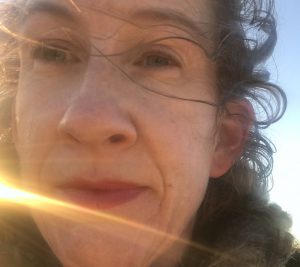 Meghan LeBorious is a writer, teacher, and meditation facilitator who has been dancing the 5Rhythms since 2008 and recently became a 5Rhythms teacher. She was inspired to begin chronicling her experiences following her very first class; and she sees the writing process as an extension of practice—yet another way to be moved and transformed. This blog is not produced or sanctioned by the 5Rhythms organization. Photos and videos courtesy of the writer.
Meghan LeBorious is a writer, teacher, and meditation facilitator who has been dancing the 5Rhythms since 2008 and recently became a 5Rhythms teacher. She was inspired to begin chronicling her experiences following her very first class; and she sees the writing process as an extension of practice—yet another way to be moved and transformed. This blog is not produced or sanctioned by the 5Rhythms organization. Photos and videos courtesy of the writer.
by meghanleborious | Feb 14, 2022 | Notes on Practice
I didn’t even know snow was in the forecast until I woke up and looked out the window.
 Following an in-person yoga class, I wavered on my plan to go to the ocean to dance the 5Rhythms – my Sunday ritual since the beginning of the pandemic. The snow was coming down pretty hard, and it was the goopy, wet kind of flakes. I didn’t have a hat and couldn’t turn one up even after rummaging through the car. In the end I decided I might as well give it a try. If it was horribly uncomfortable I could always bail.
Following an in-person yoga class, I wavered on my plan to go to the ocean to dance the 5Rhythms – my Sunday ritual since the beginning of the pandemic. The snow was coming down pretty hard, and it was the goopy, wet kind of flakes. I didn’t have a hat and couldn’t turn one up even after rummaging through the car. In the end I decided I might as well give it a try. If it was horribly uncomfortable I could always bail.
I had made my weekly pilgrimage in less temperate weather than this, I reasoned. Plus, when the weather is horrible, there’s a good chance I can actually be alone, which means I can scream, cry, move like a demon, sing loudly, or allow whatever comes through in a way that I’m unlikely to do if there is anyone around to see me.
In the car on the way, I heard Bulgarian journalist and activist Yana Buhrer Tavanier on the topic of play even in the face of grave circumstances, and carried her words into my practice. I tightened the laces on my snow boots and jogged across the wide sand, pausing to examine whatever captured my attention, allowing curiosity to be my guide.
I noticed a set of footprints and started following them toward a sand dune, talking cheerfully to myself as I roamed.
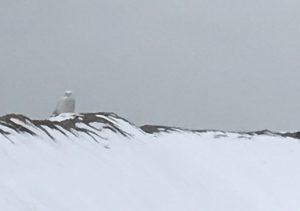 My eye caught on what I thought was a seagull perched at the top of the sand dune, barely visible with the white snow and white feathers against the white sky. I wondered why this seagull was sitting so upright, not like rubber-ducky posture like seagulls usually sit when they’re resting. This bird was vertical, with dignified shoulders. Could it be an eagle? It was also bigger than most seagulls, and totally white. It didn’t even have an orange beak. Then, she twisted her neck around like it was on a track and I wondered if she might actually be an owl.
My eye caught on what I thought was a seagull perched at the top of the sand dune, barely visible with the white snow and white feathers against the white sky. I wondered why this seagull was sitting so upright, not like rubber-ducky posture like seagulls usually sit when they’re resting. This bird was vertical, with dignified shoulders. Could it be an eagle? It was also bigger than most seagulls, and totally white. It didn’t even have an orange beak. Then, she twisted her neck around like it was on a track and I wondered if she might actually be an owl.
I took a few pictures, then crept a little closer, daring to take a video. I honestly couldn’t believe it. Owls seem magical to me – a symbol of wisdom, power, and ancient mystery. She stayed a little longer, then got spooked or maybe annoyed and took off down the beach, gliding low.
I got onto my knees and touched my forehead to the cold, wet sand.
The snow had slowed, but picked up again, landing wet on my forehead and cheeks. I began to move in Flowing around the jagged contours of ended waves. Often, I pick a spot, put my bag down, and even draw a big circle to dance inside of. This time, I let myself move wherever I wanted to, at one point going to examine some thick tangled rope, then reversing course and heading west along the edge of the water. I was grateful to be alone and vocalized loudly, moaning, crying, and even making up songs and poems, then offering them to the sea and the sky.
Today I wasn’t sure which rhythm I was in, I just knew that I needed to move. Streams of wisdom poured through and I gave voice to all of it.
The snow picked up more, to the point that the sea and sky were barely distinguishable.
I climbed up onto the dune, dancing along its spine and looking for evidence of the owl, at one point in Chaos letting myself go while trying to avoid tumbling down either side of the dune.
I walked back across the wide beach feeling tall, striding – despite the cold, despite the winter, despite the state of the world. Remembering my place in things. Heartbroken and free. Grateful. Alive. Ready.
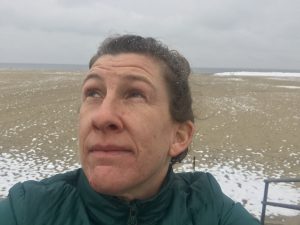 Meghan LeBorious is a writer, teacher, and meditation facilitator who has been dancing the 5Rhythms since 2008 and recently became a 5Rhythms teacher. She was inspired to begin chronicling her experiences following her very first class; and she sees the writing process as an extension of practice—yet another way to be moved and transformed. This blog is not produced or sanctioned by the 5Rhythms organization. Photos and videos courtesy of the writer.
Meghan LeBorious is a writer, teacher, and meditation facilitator who has been dancing the 5Rhythms since 2008 and recently became a 5Rhythms teacher. She was inspired to begin chronicling her experiences following her very first class; and she sees the writing process as an extension of practice—yet another way to be moved and transformed. This blog is not produced or sanctioned by the 5Rhythms organization. Photos and videos courtesy of the writer.
by meghanleborious | Apr 18, 2020 | Notes on Practice
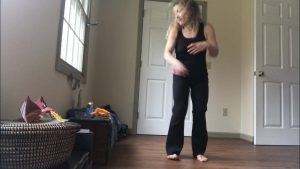 For the last two nights, I’ve slept on my back. This despite being a side-sleeper for pretty much my whole life. I have a certain way of tucking the pillow into the side of my neck, settling in, and nestling my back up to a pillow or another body. But my shoulders suffer, and the asymmetry sets me up for all kinds of misalignments. I’ve tried re-training myself many times, but I let myself go back to what’s comfortable when sleep has eluded me. This time, I think I’m on track to finally interrupt this persistent habit.
For the last two nights, I’ve slept on my back. This despite being a side-sleeper for pretty much my whole life. I have a certain way of tucking the pillow into the side of my neck, settling in, and nestling my back up to a pillow or another body. But my shoulders suffer, and the asymmetry sets me up for all kinds of misalignments. I’ve tried re-training myself many times, but I let myself go back to what’s comfortable when sleep has eluded me. This time, I think I’m on track to finally interrupt this persistent habit.
Yesterday, I logged into a zoom class that a friend led. I love his facilitation style, but I just couldn’t get into it this time. I was already feeling shut-down and discouraged, possibly because of many coronavirus deaths in my work community. Then, during the afternoon something I said contributed to disequilibrium in a whatsapp group. I apologized, but it was too late. I wasn’t wrong, exactly, but it really wasn’t my business. I wished I had stayed quiet or been more supportive. Even my ten-year-old son, Simon, felt I was in the wrong.
For a minute, I started to make a case against the person, but that fell apart pretty quickly. Then I started to make a case against myself. How I’m a bad person, how no one really likes me anyway. I started to visit past experiences, focusing on my many regrets. And I thought about all the recent emails I’ve sent that haven’t been answered, seeing it as a sign that I’m not really included or approved of, totally disregarding the fact that many people are grieving, or intolerably stressed, or have their hands overfull and answering their emails isn’t a top priority.
I really wanted to quit the group. They probably don’t want me anyway, I reasoned. But I made a recent resolution to be more present and available in group friendships–something I have struggled with–and I decided to stick it out for awhile.
 In Flowing, I rolled and stretched on the floor, keeping as much of me touching the ground as possible as I curled and flipped over, at times rolling over the back of my skull or laying flat, arms and legs outstretched, on my belly or back. On my feet, I let my arms gently follow and rub against the rest of me. I let my weight down into one foot at a time, seeing if I could connect with the center of the earth. During all of this, I was also thinking about feeling left out at work, and how to approach some of my tasks. These kinds of thought processes continued into Staccato, though I could see the pattern my mind was insisting on. In Chaos, I was more energetic, but still felt lackluster in terms of engagement. Lyrical found me briefly disengaged from persistent thinking, but still uninspired. I disconnected from the session as we moved into Stillness, and made a video for the students I teach.
In Flowing, I rolled and stretched on the floor, keeping as much of me touching the ground as possible as I curled and flipped over, at times rolling over the back of my skull or laying flat, arms and legs outstretched, on my belly or back. On my feet, I let my arms gently follow and rub against the rest of me. I let my weight down into one foot at a time, seeing if I could connect with the center of the earth. During all of this, I was also thinking about feeling left out at work, and how to approach some of my tasks. These kinds of thought processes continued into Staccato, though I could see the pattern my mind was insisting on. In Chaos, I was more energetic, but still felt lackluster in terms of engagement. Lyrical found me briefly disengaged from persistent thinking, but still uninspired. I disconnected from the session as we moved into Stillness, and made a video for the students I teach.
The video was about how our habitual fear stories can build up and cause us to feel overwhelmed, and how it is important that we learn to cut through our thoughts by coming back to the present when we start to make a case against ourselves.
In the evening, I avoided the temptation to drink wine to have a break from the difficult feelings I was experiencing. Instead, I wrote, then meditated at length, wrapped in a blanket in a dark room, lit only by one candle from my altar. I watched related thoughts arise and fall away, still making a case against myself, still feeling shut down, but gaining a little distance, and was able to sleep peacefully.
Today, things felt a little easier.
Again, I was drawn into exchanges with the same whatsapp group, but I didn’t feel disliked or disincluded. In fact, I found the people who contributed very supportive and receptive. I shared that I had been tempted to quit the group, but decided to ride it out. In the past, I’ve been inclined to shut down quickly in group relationships, but this time I wanted to try something different. I’m curious to see where it will lead, and excited about another strong community to learn from and grow with.
My biggest block in practice yesterday was in Staccato, but today I felt more connected as I joined a group of close friends on a zoom dance.
The livestream class was very clear and direct, with the teacher naming each form of each rhythm as it arose. In Flowing, I spent some time creating a perfect white circle around my home dance floor, and casting a circle spell. Then, I lost myself in weighted spins, following my intuition even if it didn’t look like typical flowing movements. The teacher offered a challenge that engaged me and I reflected that good teaching is a process of refining attention by offering hooks and challenges for students to engage with, and eventually supporting them to create refinements and challenges for themselves.
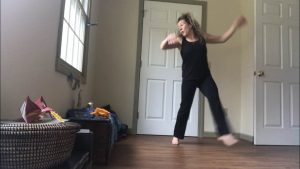 In Staccato, I found edges and definition, sinking low in a howling yoga-goddess-pose again and again. In Chaos, spin was my thread, and I followed coiling, moving like a matrix, and flapping my head wildly as the expression of the spine in perpetual motion. In Lyrical I noticed that different dancers were highlighted on the zoom screen, and I moved in partnership with that specific dancer, assuming they, too, were seeing me. In Stillness I moved into vast space, noting the movements of clouds, the many birds I could see from the window, and wondering about arcane languages.
In Staccato, I found edges and definition, sinking low in a howling yoga-goddess-pose again and again. In Chaos, spin was my thread, and I followed coiling, moving like a matrix, and flapping my head wildly as the expression of the spine in perpetual motion. In Lyrical I noticed that different dancers were highlighted on the zoom screen, and I moved in partnership with that specific dancer, assuming they, too, were seeing me. In Stillness I moved into vast space, noting the movements of clouds, the many birds I could see from the window, and wondering about arcane languages.
After Stillness drew to a close, we came together in conversation. My newly-created zoom pattern is that I bail as soon as the music stops. Often Simon is drawing me, but it might also be that I’m uncomfortable in this kind of group friendship. Today I enjoyed the conversation, contributing and listening patiently.
Why might it be helpful to interrupt our persistent habits? In general, defaulting to our rehearsed patterns (and the mind-stories that support how we currently see ourselves) functions to keep up trapped in our small sense of self, and our painful, futile efforts to sustain our fragile ego. At this time, our patterns are rocked, and we have the choice to either dig in and insist on them, or to see them in the clear light of day and change our way of relating to them.
If there is any value to be gathered from this time–though any consideration of value in the face of such devastation is surely an expression of privilege–it is that it is an opportunity to confront and interrupt our habits, certainly on an individual level, and I hope, I pray, I intend, on a societal level, that we may establish new habits, new ways to share resources, and new ways to value our myriad contributions.
April 16, 2020, Broad Brook, Connecticut
by meghanleborious | Mar 22, 2020 | Notes on Practice
Pandemic. Coronavirus. Social Distance. Self-isolate.
In this time of worldwide fear and pain, practice is more important than ever. But what we usually do to practice the 5Rhythms is not safe at this time. So we are called on to be flexible, creative, and to test our ingenuity.
I admit that I miss dancing in big groups. I miss patient, belly-to-belly hugs on greeting. I miss the collective shifts of the crowd, like when a spontaneous chaos circle breaks out. I miss darting around into the empty spaces; I miss falling unexpectedly into partnership in perfect alignment; and I really, really miss dancing with my friends.
All of that said, I don’t think that practicing individually should only be considered as an austerity measure. In my experience, individual practice can also be a powerful teacher.
***
The first time I formally engaged in individual 5Rhythms practice was during a winter retreat at a Tibetan meditation center. I was seven months pregnant with my son, Simon, at the time. It was an eight-day retreat; and several powerful energetic teachings that are usually taught separately were taught consecutively.
It totally overloaded my circuits; and I took to the miles of rocky trails to process and integrate so much new energetic information at once. Flat wooden platforms used for tent camping during the warm seasons were interspersed throughout the woods; and I started using them as dance floors instead, throwing down my heavy coat as heat rose in my body and letting loose.
In Flowing one day, I danced on one of the platforms with one hand on a tall stick. I moved around it like it was an axis, dipping and spinning low, switching hands, curving my head, and threading my hips and spine around it.
Though I didn’t plan on it, before long, I decided to make practice formal, and I moved through all five rhythms in the woods at least once a day, often returning to the center windblown and red-cheeked, feeling like I had a glowing secret. One day, late afternoon sun blazed through the trees and through my body, dazzling in its intensity. On another day, I imagined that a pair of small dragons raced out of the woods to dance with me, both with a playful ardency, and with sinewy, powerful movements.
***
Like many, I’ve been practicing on my own a lot lately, as coronavirus locks down cities and countries. At this time, I’m very thankful for practice. It’s helped me to emotionally regulate, to integrate experiences, and to be connected to my communities.
There’s nothing like practicing in a room full of 5Rhythms dancers, where there are endless opportunities to explore relationship, and to see yourself as you are reflected in the people around you.
However, as rich as group practice is, there is also territory that can only be explored in individual practice.
Individual practice is also totally portable, free, and empowers you by allowing direct access to what we might call source–direct access to the depths of human experience–without the need for a teacher to act as a facilitator.
Gabrielle Roth, the creator of the 5Rhythms practice, conceived of the 5Rhythms as a way to relate to the creative process. She believed that rather than discovering or inventing something, she was creating a map for what was already inherent in human experience.
Working with a certified 5Rhythms teacher makes it easier to access deeper layers of reality, when we participate with full awareness in the dynamic, changing display of phenomena, but we actually have all the tools we need to connect with that same source even on our own, especially after we have already spent some time practicing in community.
Once, at my parents’ house when Simon was still an infant, nearly ten years ago, I was dancing a 5Rhythms wave with him in the living room. Within moments, I was filled with emotion. Though I had spent countless hours in the same room, dancing the rhythms there brought me to a layer underneath the mundane. It was like I was watching videos of infinite family moments inside the same room, where my own mother had been a child, and where I had been a child. I could sense and see my place in it, and see my son’s place in it, part of an unbroken line of human beings, the expression of countless acts of love and courage, and, too, of regret, grief, and unexpressed potential.
***
Creating some kind of an opening and closing ritual can support our practice, and provide cues to the unconscious that it is time to switch out of mundane gear. It can also be helpful to create some kind of visual or altar. One long-time dancer says, “My practice includes setting up at alter, which is usually a recent drawing. In the start of a practice, I think about all the giving beings I’ve ever danced with. I think about all the beautiful places I’ve danced. I try to do this at the start and end of every practice.”
Another dancer expressed that she finds it helpful to set an intention at the beginning of practice, and to return to that intention frequently, then to end with it.
***
During the summer of 2015, Simon and I traveled to Costa Rica. There, he went to camp during the days and I spent the time writing and dancing with the sea.
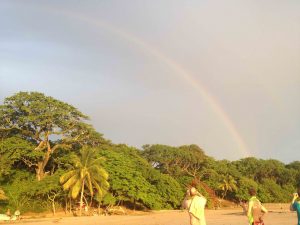
At first it was kind of boring.
I tried to seek out or set up informal dances with others, but it didn’t work out.
So there was no music blazing from high tech speakers, no interpersonal intrigue, no one to partner with and vibe off of, no one to take care of, no one to take care of me, and no external prompts from a teacher to pull me along.
That is to say, it was all up to me.
For the first few days, my dances were uninspired. I remained committed, though, and continued to spend the days dancing and writing. I began to go to a beach called Playa Pelada every day. It was remote enough that few people walked all the way there, but not so remote that getting there was impossible.
I sent some writing to one of the leaders of 5Rhythms, with the disclaimer,
“I know it’s not 5Rhythms practice if it isn’t led by a 5Rhythms teacher, but…”
She wrote back, “Actually, it can still be practice. It’s just that it’s individual practice.”
This validation helped me to believe in what was already unfolding, and I committed myself even more resolutely to practice–at minimum, to move through each of the 5Rhythms in sequence daily.
That brings up another benefit to individual practice–that it allows us to practice daily, even when schedule, geographic location, or, a worldwide health emergency make it impossible to get to a 5Rhythms class.
During low tide at Playa Pelada, warm tidal pools formed and I explored every crevice of the land, often moving in Flowing for long periods, and moving back into Flowing again and again, even as the other rhythms presented.
The first time that I danced the transition from low tide to high tide, I was cured of the problem of boredom.
Playa Pelada gave me so much to work with. There was a small island directly in front of the beach, and at high tide, the wild sea would rush around it on both sides, then meet in the center in a crashing tangle of waves. Shifting sand, rocks and debris would crash at my ankles and radically shift the very ground under me. I never tired of responding, arching, casting, turning over, flapping up fast, letting my hips recede as the waves pulled me, and coasting in circle after circle after circle.
Sopilote vultures arced and soared above the high cliff walls. Clouds shifted and raced. Rainbows appeared and dissolved. Iguanas, hermit crabs, and alligator-like caymen flashed in glimpses. Huge driftwood trees disappeared overnight. The sea rushed in and receded. And I witnessed this rich display and moved with all of it, leaving nothing out.
During our last week in Costa Rica, I danced from one low tide until the next–nearly twelve hours of moving–beginning before dawn. As the sun rose over the island and lit the sky, I immersed myself in a spontaneous ritual, using salt dyed with rainbow colors to create a giant spiral on the sand. I danced from its edge, where I felt I was in the relative, everyday world, along the path to its center, where I imagined I was in absolute reality, a place where different dimensions intersect. I moved back and forth through this spiral throughout the early morning hours as the ocean began to gather into a crescendo and eventually erased the spiral, gathering it back into herself.
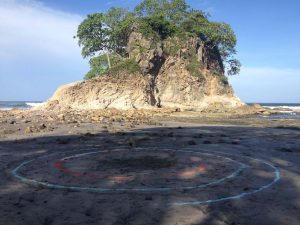
Practicing individually in beautiful, powerful places has expanded the possibilities in my own dance. I carry these experiences in my body, even when I enter back into dancing indoors in community. For example, dancing with a powerful river, I visited its deep, cold, dense, black river bed. Now, in Stillness, I can still connect with this experience and remind myself of my own depths, the dark, cool currents that run deep inside me.
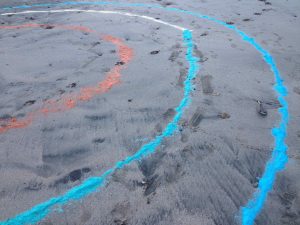
The year after Simon and I were in Costa Rica, we spent summer on the southeastern coast of Ireland. There again, Simon attended camp and I spent the days dancing with the sea, writing and making artwork.
The sea was indescribable. Gigantic. The tide goes out nearly a mile, then rushes back in at high tide to pummel everything in sight. 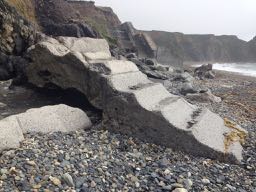 Slowly, as I danced with integrity over many sessions, this powerful place revealed itself to me, initiating me to its secrets.
Slowly, as I danced with integrity over many sessions, this powerful place revealed itself to me, initiating me to its secrets.
In general, I have often felt that I needed to keep myself in Flowing longer than felt intuitive. This was so I could be responsible and find the ground beneath me before taking on any other investigation, especially when dancing with other people.
In Ireland, I learned that another benefit of practicing independently is that I can work with the mercurial shifts of energy as they arise. Instead of holding myself in Flowing at the beginning, I noticed that even once I did move into Staccato, I moved back into Flowing many times. It wasn’t an all-or-nothing thing. Even in Chaos, I still found myself going back to Flowing.
Here, the stakes were different. Attending to the many small subtle shifts of energy as I fluctuated between different rhythms allowed me to follow intuition in a new way, and to observe nuances that weren’t always apparent during a wild collective dance. One day a wave followed this pattern: Flowing, Staccato, Flowing, Staccato/Chaos, Staccato, Flowing, Flowing Chaos, Chaos, Flowing, Lyrical, Chaos, Lyrical, Chaos, Flowing, Flowing Lyrical, Stillness.
***
This week, as coronavirus rolls in crushing waves over the world, like many, I’ve been practicing independently in my own home. I would prefer for Simon and I to be fully quarantined, both to keep us safe and to not proliferate germs, but we have roommates who are still going in and out, so my obsessive cleaning and containment procedures might be for naught.
Yesterday, I danced a five-song wave, one song for each rhythm. It all seemed very mundane at first, with afternoon sun coming in the window and falling in angled squares on my worn living room rug and the cat sitting next to me on a rumpled couch blanket. But soon, it tore itself from my throat and broke open. I spun and angled and dipped in Flowing, letting in fear. In Staccato, I was fierce, expressive, decisive. In Chaos, I was gigantic, kinetic, powerful. In Lyrical, I expanded beyond my small conception of who I am. In Stillness, I offered the merit of my practice to my family and my friends all over the world, and the afternoon living room seemed crowded with spirit guides, ancestors, and deities.
This territory is totally uncharted and the stakes are high.
For 5Rhythms practitioners and to everyone who has a committed practice, now is the time to lean into it.
Early in New York’s wave, I noticed I was trying to bear down hard until the crisis passed. But soon realized that coronavirus might last for an extended period, and that bearing down and wishing time away will only cause me to wish away moments of this precious life, and to close ourselves down emotionally and energetically. Somehow I have to come to terms with it. Better to open to what is, even when it is uncertain, even when we are met with grave hardship, and even when we are forced to stand face-to-face with our deepest, most terrifying fears.
by meghanleborious | Jul 20, 2019 | Other Writings
“It’s 2019. Just thought I’d let you know that,” jokes Tanya Goldman, who is leading the first Sunday Sweat Your Prayers 5Rhythms class of 2019 in New York City. She doesn’t specifically mention New Year’s resolutions, but she does say, “One thing I’ve learned is if you want to change, you have to move. Physically, mentally and emotionally. It doesn’t just happen.”
Tanya doesn’t talk much during class but somehow manages to bring out the best in people. For this Sunday morning class, the big dance studio is jam-packed and notably porous, the many selves melting in and out of each other, part of a big, collective self.
As the class begins, Tanya leads us in a long, patient Flowing. She seems confident that we’ll stay with her, even if she doesn’t rush to entertain us. In Staccato and a wild Chaos, I dance with a friend who’s seated in a chair, bringing me down low. I also share several dances with a friend who has been a frequent partner over ten or more years. In contrast to our usual ebullient, wide-ranging partnership, we tuck into a pocket, sustainable, riding energy patiently. In Lyrical, I join with another friend, leaping into flight with my shoulders and chest wide open, tears streaming down my face.
At the height of joyful intensity, Tanya plays the 90’s club anthem ’Last Night a DJ Saved My Life with a Song‘. I recognize it immediately, sinking low in a pumping warrior cry as the room explodes.
Tanya has a way of doing this. Of building things up and building things up, then dropping the exact perfect song at the exact perfect moment; and if I had had any sort of conscious thought, it probably would have been: This is heaven. Life could not possibly get better than this.
At the end of the class, I pause to chat with one of the friends I’d partnered with. “That was just amazing,” he says, wide-eyed. I nod. “She is incredibly trustworthy. I feel like it’s safe to totally let go. Like she is holding space and witnessing what is unfolding in, like, a clean way, or something.”
***
I think back to a Heartbeat workshop that Tanya and I both attended ten years before. I was having a joyful and pleasant experience, but it shifted when we were placed into groups of three for an exercise. One person was to move with a certain prompt in mind and the other two would witness the person who was moving, then we would change roles. One of my partners was this very expressive woman who had a huge dance. I had cheerfully joined her in partnership many times during the workshop, but this time when she was supposed to witness me, I didn’t feel like she was seeing me at all. Like she was just totally wrapped up in her own awesomeness. I’m pretty extroverted and don’t feel invisible very often, but somehow this really hurt me.
Thankfully, Tanya was my other partner. Curiously, it wasn’t until I reflected later, still nursing wounds from the experience, that I realized that although one partner had failed to see me, Tanya had very much seen me. I realized what a valuable friend she is and hoped that I could return the favor of her clear-seeing, something I continue to try to live up to.
***
Tanya, who has been a 5Rhythms teacher since 2014, sat down with me last spring to share some thoughts on her life and process. We planned to get together after a different Sweat Your Prayers class in the West Village for this interview. I hadn’t really thought through where we would set up but considered a few local restaurants without fully appreciating how much Tanya has to think things through in advance. Tanya has a disability that affects motor ability and uses a walker to get around, so accessibility is an issue, and she also let me know that she is not able to eat solid food. So instead of a restaurant, we went to a smoothie place at the corner, then sat down together at the closest Starbucks.
Once settled, Tanya patiently blinked her clear, blue-green eyes, and sipped at her smoothie, inviting the first question.
“When did you start practicing the 5Rhythms and what brought you to 5Rhythms for the first time?” I asked.
“I started practicing in 2008,” she began. “I’d already been doing Contact Improv for many years, since college.”
Tanya shared that she went to Oberlin, where Contact Improv was invented, and in fact practiced in the very studio where Contact Improv originated.
“I loved it, and learned that I could really be there, could really be in it despite my limitations. As my disability progressed, it got harder to do Contact Improv. It’s really all about partnering. In partnering, it was like my partner shared my disability, so it would limit what they could do, and not everyone was ok with that.”
She also shared that she didn’t always feel like she was included in the community, and added, “I decided I needed to find another dance community where it would be ok to dance on my own.”
Next, she became part of the Dance New England community and someone there suggested she try the 5Rhythms.
“For my first class, Jonny (Jonathan Horan, the director of 5Rhythms and son of its creator, Gabrielle Roth) was teaching. I didn’t understand it at all, but I felt accepted. Then, it was many years before I started to learn what it was all about.”
The next question I asked was, “How has your practice changed over time?”
“Well, my body has changed. The biggest change is that I now use a walker. That’s been in the last six-to-eight months. In the beginning, my balance was so much better. I could skip and run. Particularly after I got the walker, I was aware that my balance was really changing. For a while, I was falling all the time. My mind wanted to dance faster than my body could handle. The mind doesn’t want to accept the body’s limitations, but once you can go with the changes, then it’s so much easier. And now I’m not falling! But I’m definitely still moving.”
“Do you feel more comfortable with being off balance?”
“I don’t feel out of balance. I’ve come to accept and find the grace within my own dance. But it’s not a definite. One day it’s there and the next it’s like ‘where is it?’”
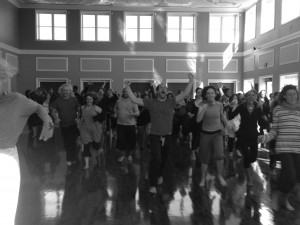
Then, I asked, “Do you have a ‘home’ rhythm?”
“Not really. For me, it’s all about change. We’re always changing and life is always changing.”
“Tanya, what made you decide to become a 5Rhythms teacher?”
“I did a class with Sylvie Minot and she talked about teaching 5Rhythms to inmates in prisons. I thought that was amazing. Not that she was teaching in prisons, but that she was bringing the work to disadvantaged people. I’m trained as a social worker. I always wanted to help people, to change lives for the better. In fact, when I started the teacher training, I was still working as a social worker. Halfway through the teacher training, I got laid off from my job, along with my social worker colleagues. After, I was too exhausted to go back to work, but I feel like being a 5Rhythms teacher is my offering, my contribution.”
“Did you have to overcome significant obstacles to undergo the teacher training?”
“I definitely had to overcome obstacles. The first was financial, especially after being laid off after the first module. Maybe even more significant were the mental obstacles. I had an internal story that I wasn’t even fully aware of that I had nothing special to offer. At an Open Floor workshop with Andrea Juhan this story came out and I was finally able to deal with it. That was a big turning point for me.”
“While I was going through this, though, I felt supported by Jonny (Jonathan Horan). During the training, we had to learn a kind of two-step pattern, which was obviously pretty hard for me, but I did it.”
She also shared that Jonathan said, “When you do this with Tanya, hold her hands,” and how much she appreciated that Jonathan seemed to get her needs.
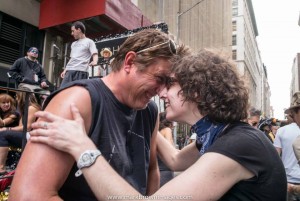
“What, in your opinion as a 5Rhythms teacher, is the essence of 5Rhythms practice?”
“For me, it’s about permission and possibility; and it’s about getting out of your own way.”
“What, if anything, makes your perspective on the 5Rhythms unique?”
“I think as a person with a disability, I give a lot of permission to people in general. And, as a person with a disability, I also bring a lot about being willing to be vulnerable. My experience is about being very vulnerable every day. I wear my vulnerability on the outside.”
***
Tanya and I shared a workshop this weekend that was focused on the 5Rhythms emotional map, Heartbeat. At one point, we were working with the emotion of anger, and the room was explosive. We were instructed to line up at one end of the room and several sets of partners at a time would cross the floor to the other side, expressing the emotion of anger with our bodies.
One issue I’ve personally been working with is how to know when to help people and when not to, and how I relate internally to those two options. In fact, in a Sunday class the week before, a man had come in with a walker and paused at the side of the dance floor. I happened to be near him and asked if he wanted a chair. He was irate: “Why would I need a chair? There’s nothing wrong with me!”
Although I have never discussed it with Tanya, I wonder if, because of her disability, she has to contend constantly with people projecting their ideas of what her experience is and should be onto her. When I was pregnant in 2009-2010, I struggled with the visibility of my pregnant body and how much people wanted to tell me about my experience. I felt like a walking screen for everyone’s projections, and that if I heard one more birth horror story I might possibly harm someone.
With Tanya, I want to be available to help, but also don’t want to insult her by offering, and sometimes I get myself tangled in stories about helping/not helping instead of simply trusting myself to communicate effectively and do what’s needed. When we were lining up in the anger exercise, Tanya, who happened to be next to me, turned to me and shook her head, blinking her eyes and looking unhappy. “Does this feel like too much?” I asked. She nodded. “Do you want me to get you a chair?” She nodded again. I carried a chair over, placed it off to the side, and she sat down. The week before, I’d shared a dance with a broken-ankled friend who needed to stay seated, and, deep in a vigorous chaos, she had traveled laterally at least ten feet without harming the floor surface at all. Recalling this, I asked,
“Tanya, do you want me to push you across in the chair?”
Her eyebrows raised and her face lit up. “Really?”
She gave a clear “Yes” nod, so I moved behind the chair and pushed her forward. Tanya seemed delighted as I gently zigged and zagged across. My own dance had vigor and specificity, a Staccato I’ve been searching for lately – a self I’ve been searching for lately –especially as my roles in the world become more complex and I step into more positions of leadership. When we were almost to the end, I signaled to another dancer to please take over and she got the message immediately. I ran back to the first side of the room and crossed again, on my own this time, in an individual anger dance, unselfconsciously ferocious, owning my power without insisting on it.
The next time across, I asked a mutual friend to join Tanya and me. We were just as wild, zigzagging across both in partnership and as a trio, and changing roles halfway across.
I’m sure I benefited much more than Tanya in this exchange, and remain grateful to her for her willingness, courage, and openness.
The next and final day of the workshop, when we greeted each other, Tanya took the time to say, “I feel seen.” I recalled my resolution following a Heartbeat workshop more than a decade before to return the favor of Tanya’s clear-seeing when I had felt painfully unseen by one dancer, but seen by Tanya.
I don’t know if she meant specifically seen by me, but however she meant it, I looked at length into her light eyes and my heart flooded up. So many of the lessons Tanya teaches me are the ones that we already know deep down but conventionally forget, such as the fact that one of the deepest human needs is to feel seen, and that one of the greatest gifts we can offer is to see each other.
***
“Do you have any advice for new dancers?” I asked as our interview drew to a close.
“Have fun! Try not to take yourself too seriously and don’t worry if you don’t ‘get it’ at first. I tried to read one of Gabrielle Roth’s books in the beginning and I didn’t understand it. I couldn’t really hear what the teachers were saying at first, either. I’m very kinaesthetic; I learn through the body. I had to practice before I could get it intellectually.”
“And do you have advice for experienced dancers?
“Same thing! And also keep your mind open, keep your eyes open, and don’t get fixed on a certain idea.”
The final question was, “In closing, do you have a favorite quote or passage from Gabrielle’s teachings?”
“Waves move in patterns. Patterns move in rhythms. A human being is just that – energy, waves, patterns, rhythms. Nothing more. Nothing less. A dance.”
by Meghan LeBorious, based on an interview with 5Rhythms teacher Tanya Goldman on May 27, 2018, and journal notes from 2008-2019.
Originally published in the 5Rhythms Tribe newsletter on April 16, 2019. Photographs courtesy of Tanya Goldman and Jonathan Horan.
 Today I was strongly aware of the transition from Staccato into Chaos, because of how my relationship to gaze shifted. In Staccato, my eyes would find something, then I would lock into it, narrow my field, and respond. But when my gaze started to land on things at the same time that I was starting to respond to them, I started to feel the shift into Chaos. Whereas in Staccato, my vision was targeted, in Chaos, vision started to attend more to the peripheries, scanning rapidly for movement at the edges of my field of vision. As my head and body released more and more, vision started to get blurry, and flashed through sky, trees, river, feet, and snow with increasing speed.
Today I was strongly aware of the transition from Staccato into Chaos, because of how my relationship to gaze shifted. In Staccato, my eyes would find something, then I would lock into it, narrow my field, and respond. But when my gaze started to land on things at the same time that I was starting to respond to them, I started to feel the shift into Chaos. Whereas in Staccato, my vision was targeted, in Chaos, vision started to attend more to the peripheries, scanning rapidly for movement at the edges of my field of vision. As my head and body released more and more, vision started to get blurry, and flashed through sky, trees, river, feet, and snow with increasing speed. Meghan LeBorious is a writer, teacher, and meditation facilitator who has been dancing the 5Rhythms since 2008 and recently became a 5Rhythms teacher. She was inspired to begin chronicling her experiences following her very first class; and she sees the writing process as an extension of practice—yet another way to be moved and transformed. This blog is not produced or sanctioned by the 5Rhythms organization. Photos and videos courtesy of the writer.
Meghan LeBorious is a writer, teacher, and meditation facilitator who has been dancing the 5Rhythms since 2008 and recently became a 5Rhythms teacher. She was inspired to begin chronicling her experiences following her very first class; and she sees the writing process as an extension of practice—yet another way to be moved and transformed. This blog is not produced or sanctioned by the 5Rhythms organization. Photos and videos courtesy of the writer. Following an in-person yoga class, I wavered on my plan to go to the ocean to dance the 5Rhythms – my Sunday ritual since the beginning of the pandemic. The snow was coming down pretty hard, and it was the goopy, wet kind of flakes. I didn’t have a hat and couldn’t turn one up even after rummaging through the car. In the end I decided I might as well give it a try. If it was horribly uncomfortable I could always bail.
Following an in-person yoga class, I wavered on my plan to go to the ocean to dance the 5Rhythms – my Sunday ritual since the beginning of the pandemic. The snow was coming down pretty hard, and it was the goopy, wet kind of flakes. I didn’t have a hat and couldn’t turn one up even after rummaging through the car. In the end I decided I might as well give it a try. If it was horribly uncomfortable I could always bail.  My eye caught on what I thought was a seagull perched at the top of the sand dune, barely visible with the white snow and white feathers against the white sky. I wondered why this seagull was sitting so upright, not like rubber-ducky posture like seagulls usually sit when they’re resting. This bird was vertical, with dignified shoulders. Could it be an eagle? It was also bigger than most seagulls, and totally white. It didn’t even have an orange beak. Then, she twisted her neck around like it was on a track and I wondered if she might actually be an owl.
My eye caught on what I thought was a seagull perched at the top of the sand dune, barely visible with the white snow and white feathers against the white sky. I wondered why this seagull was sitting so upright, not like rubber-ducky posture like seagulls usually sit when they’re resting. This bird was vertical, with dignified shoulders. Could it be an eagle? It was also bigger than most seagulls, and totally white. It didn’t even have an orange beak. Then, she twisted her neck around like it was on a track and I wondered if she might actually be an owl. Meghan LeBorious is a writer, teacher, and meditation facilitator who has been dancing the 5Rhythms since 2008 and recently became a 5Rhythms teacher. She was inspired to begin chronicling her experiences following her very first class; and she sees the writing process as an extension of practice—yet another way to be moved and transformed. This blog is not produced or sanctioned by the 5Rhythms organization. Photos and videos courtesy of the writer.
Meghan LeBorious is a writer, teacher, and meditation facilitator who has been dancing the 5Rhythms since 2008 and recently became a 5Rhythms teacher. She was inspired to begin chronicling her experiences following her very first class; and she sees the writing process as an extension of practice—yet another way to be moved and transformed. This blog is not produced or sanctioned by the 5Rhythms organization. Photos and videos courtesy of the writer.  For the last two nights, I’ve slept on my back. This despite being a side-sleeper for pretty much my whole life. I have a certain way of tucking the pillow into the side of my neck, settling in, and nestling my back up to a pillow or another body. But my shoulders suffer, and the asymmetry sets me up for all kinds of misalignments. I’ve tried re-training myself many times, but I let myself go back to what’s comfortable when sleep has eluded me. This time, I think I’m on track to finally interrupt this persistent habit.
For the last two nights, I’ve slept on my back. This despite being a side-sleeper for pretty much my whole life. I have a certain way of tucking the pillow into the side of my neck, settling in, and nestling my back up to a pillow or another body. But my shoulders suffer, and the asymmetry sets me up for all kinds of misalignments. I’ve tried re-training myself many times, but I let myself go back to what’s comfortable when sleep has eluded me. This time, I think I’m on track to finally interrupt this persistent habit. In Staccato, I found edges and definition, sinking low in a howling yoga-goddess-pose again and again. In Chaos, spin was my thread, and I followed coiling, moving like a matrix, and flapping my head wildly as the expression of the spine in perpetual motion. In Lyrical I noticed that different dancers were highlighted on the zoom screen, and I moved in partnership with that specific dancer, assuming they, too, were seeing me. In Stillness I moved into vast space, noting the movements of clouds, the many birds I could see from the window, and wondering about arcane languages.
In Staccato, I found edges and definition, sinking low in a howling yoga-goddess-pose again and again. In Chaos, spin was my thread, and I followed coiling, moving like a matrix, and flapping my head wildly as the expression of the spine in perpetual motion. In Lyrical I noticed that different dancers were highlighted on the zoom screen, and I moved in partnership with that specific dancer, assuming they, too, were seeing me. In Stillness I moved into vast space, noting the movements of clouds, the many birds I could see from the window, and wondering about arcane languages.




